|
| |
| |
| |
Portrait of the Child as Sitter
Children of a Golden Age
Strange as it may seem today, until fairly recently it was thought that in early modern Europe children were not very highly valued and were appreciated not as children but simply as a kind of proto-adults. Research by various historians has shown convincingly that this is a misconception. The way in which children are regarded may vary through time and space; but parents love their children and care about them, and they have always done so.
That this loving care is only rarely reflected in the visual arts appears to have a very prosaic reason. Portraiture as a genre in painting has only come into being since the fifteenth century, and its status since then has always been very low. Even today in auctions and art sales portraits are rarely considered precious as such. It is a famous sitter that makes a portrait attractive; otherwise it has at least to be by Titian or Van Dyck to make a really high price.
Paintings were valued and painters were admired because of their skill, and the way to show excellence in painting portraits was in the handling of faces and hands. The painting of clothing, jewellery and background was considered craft rather than art and did not offer the average painter an opportunity to stand out from his many colleagues. And it is precisely this low status of portrait painting that explains why children's portraits are so rare in European art. To fit in with existing portrait galleries and with tradition a painter was almost obliged to portray children at full length, which implied lots of clothing and background and very little real artwork. Child portraiture was the lowest form of this poorly rated genre, and that remained the case for many centuries.
When we look at the numbers of such works, there appears to be one exception: the Low Countries. Especially in the seventeenth century - the socalled Golden Age of the Dutch Republic - comparatively many children's portraits were painted. In the rest of Europe only the highest nobility saw fit to have their children painted, often together with their parents. Individual portraits of children and youngsters were in many instances made with the purpose of making the heir known to his future subjects or as a tool in the very serious game of finding a profitable match. In the Dutch Republic there was no royal court and the old nobility had little direct political influence,
| |
| |
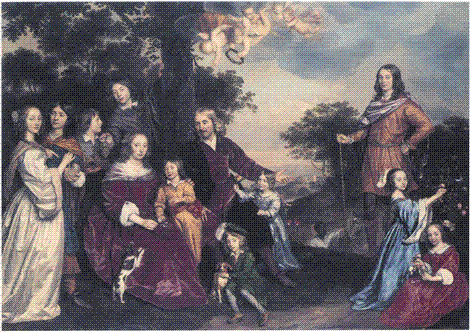
Jan Mijtens, Willem van den Kerckhoven and his Family. 1652 / 1655. Canvas, 134 × 182 cm. Haags Historisch Museum, The Hague.
but in the cities there was a large group of wealthy citizens who aspired to aristocratic status.
These people were proud of their newly-gained riches and displayed a marked self-confidence. A favourite way of showing off in public was the group portrait of men in public service of the kind for which painters like Rembrandt and Frans Hals have become famous. For private consumption, the really rich had themselves painted in family portraits or in portraits of individual family members. In this group children's portraits are still a rare exception, but compared with the rest of Europe their number does stand out. For the first time ever, a large number of these children's portraits have been brought together in an exhibition devoted solely to this subject. This exhibition was on show in the Frans Hals Museum in Haarlem (7 October - 31 December 2000) and in the Antwerp Royal Museum of Fine Arts (21 January - 22 April 2001) and came with an impressive catalogue published both in Dutch and in English.
| |
Real or metaphorical
One of the problems facing the organisers of this exhibition was to distinguish between actual portraits on the one hand and genre paintings on the other. In the latter category the persons symbolise specific emotions or tell a story which is in most cases intended as a lesson in good behaviour. This involved a great deal of research into the provenance of the paintings themselves as well as into the genealogy of the supposed sitters. Of course this
| |
| |

Cornelis de Vos, Anton Reyniers, Maria Le Witer and their Five Children. 1631. Canvas, 170.3 × 244.1 cm. Museum of Art, Philadelphia (W.P. Wilstach Collection).
did not lead to a positive result in every case, but where it did the genealogical information is given in detail in separate entries in the exhibition catalogue. No specific distinction was made between portraits of individual children (or sometimes small groups of children) and family portraits in which one or both parents are shown together with their offspring.
Such family groups were particularly popular in the Northern Netherlands in the seventeenth century. Quite often the painting depicts not only the living offspring, but also those who died before the painting was made. Deceased children are most often portrayed as little angels or putti. A fine example of this is Jan Mijtens’ Willem van den Kerckhoven and his Family. The painting was originally completed in 1652, but when a new son was born to the family, he was added to the painting in 1655, showing the importance attached to having the family portrayed in its entirety. Also included in the background is a black servant boy leading a horse. Since the Van den Kerckhoven family seems to have had no direct connection with the Dutch West Indies Company or the slave trade, the inclusion of this servant boy must be seen as an indication of the family's wealth.
As a type source for the composition of family portraits like this one, the authors of the exhibition catalogue refer to the wings of altarpieces and memorial tables which were fashionable until the time of the Reformation. In the Dutch Republic painters used this model rather freely and experimented with the composition and the grouping of the figures in the painting. More traditional - but also twenty years older - is a comparable work by the Antwerp master Cornelis de Vos: Anton Reyniers, Maria Le Witer and their Five Children. Here the merchant Anton Reyniers and his two sons occupy
| |
| |

Govert Flinck, A Girl as Flora. c. 1640. Canvas, 117 × 90 cm. Musée des Beaux-Arts, Nantes.
the left side of the painting, while his wife and their three daughters fill the right hand side. Between the two parents, who are seated, is a table covered with an oriental carpet. Against the back wall and above the table we see a painted double portrait, most probably depicting Anton Reyniers' parents. An illegitimate daughter of whom we have documentary evidence is not included in the painting.
Where the children portrayed could not be identified, the problem arises whether or not we have a portrait in the strict sense of the word. A case in point is A Girl as Flora by Govert Flinck. The girl wears a fantasy costume and carries a large bunch of flowers and obviously represents Flora, goddess of flowers and springtime. Without the girl's identity and with no clue to the context in which the painting was made, this work cannot strictly speaking be seen as a portrait. That it has been included in the exhibition nevertheless is probably due to its high quality. In the catalogue it is compared with Rembrandt's
| |
| |
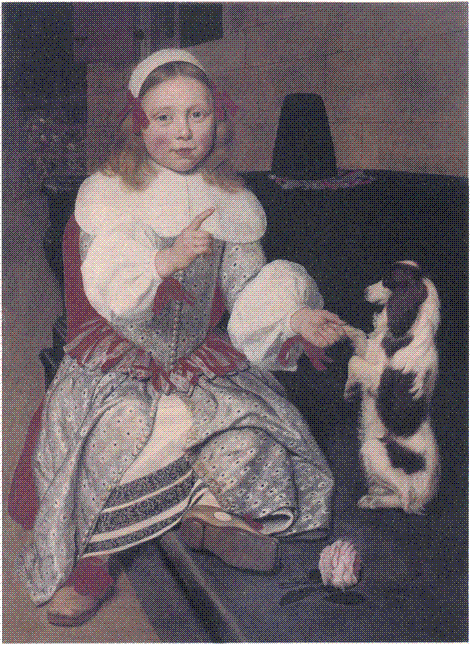
Ludolf de Jongh, Boy Training his Dog. 1661. Canvas, 97.8 × 71.4 cm. Virginia Museum of Fine Arts, Richmond (The Arthur and Margaret Glasgow Fund).
Saskia as Flora (1634), which is not a portrait even though in this case the identity of the model is known.
In yet another painting we see a Boy Training his Dog. Again the sitter has not been identified; the painting is by Ludolf de Jongh. The scene is a common one in Dutch paintings of this period and is a metaphor for effective child-rearing. Only the fact that in this case the young boy and the dog are so prominently the main subject of the painting tends to suggest that in this case we actually do have a portrait (with an unknown sitter). A similar instance is the portrait of an anonymous Four-Year-Old Girl with Cat and Fish by Jacob Gerritsz. Cuyp.
| |
| |
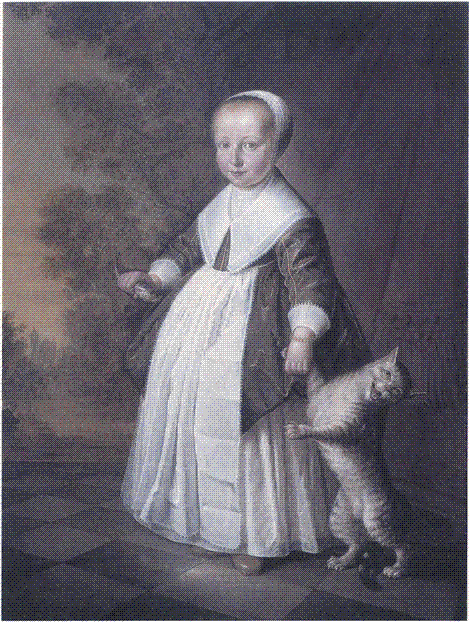
Jacob Gerritsz. Cuyp, Four-Year-Old Girl with Cat and Fish. 1647. Canvas, 108 × 80 cm. Private collection.
| |
Children at their finest
In the exhibition the paintings are grouped thematically. The first group shows ‘The New Family’, the rise of the nuclear family of parents with their children that became the norm in the sixteenth century. Also included here are examples of late fifteenth-century portraits of individual youngsters as young rulers or rulers-to-be. Sixteenth-century portraits of children of rich citizens are grouped under the second theme: ‘The First Steps’. ‘Learning and Playing’ is a self-explanatory title. Here children are shown in their daily occupations, sometimes with one educating the other as in the rather baroque The Education of Anna Maria Trip by her Sister Margarita as Pallas Athena by Ferdinand Bol. Related to this is the group of paintings in which the children are dressed up as - in most instances - mythological figures. Of course, the above-mentioned double-portrait by Bol fits into both themes. In others, boys appear in full hunting dress complete with dog and bird of prey.
| |
| |
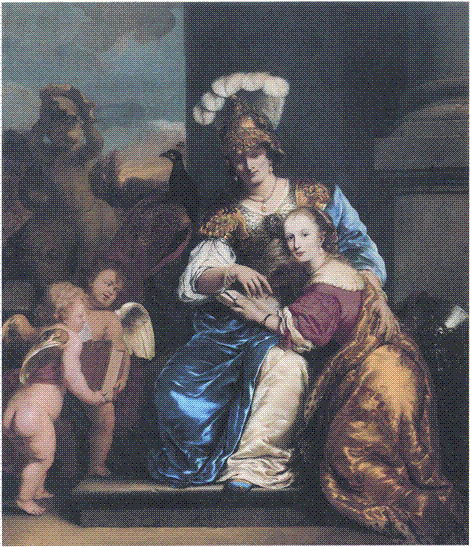
Ferdinand Bol, The Education of Anna Maria Trip by her Sister Margarita as Pallas Athena. 1663. Canvas, 208 × 179 cm. Rijksmuseum, Amsterdam.
Very intimate and moving are the post-mortem portraits. Here we see a rather documentary and anonymous painting of the Dordrecht quadruplets. Inscriptions give the names of the children and the number of days and hours each of them lived as well as a line from Psalm 127 on a banderole: ‘Lo, children are an heritage of the Lord: and the fruit of the womb is his reward.’ Individual portraits of infants and toddlers on their deathbeds occur as well and have lost nothing of the power to move over the ages. More clearly than anything else they show the grief the parents must have felt at the loss of their dearest possession.
The final theme is the apotheosis of the exhibition. Here we see ‘Children at their Finest’, beautifully executed portraits of seventeenth-century children in beautiful clothes, often surrounded by toys and caught by the painter in the same natural and spontaneous way we now expect from a professional photographer. In this group we also find again the highest nobility of the Dutch Republic, for instance in the portrait painted by Adriaen Hanneman
| |
| |

Anonymous, The Children of Jacobus Pietersz. Costerus and Cornelia Jans Coenraadsdochter (The Dordrecht Quadruplets). 1621. Panel, 75 × 104 cm. Dordrechts Museum.
of the young William III, Prince of Orange and showing the influence of Anthony van Dyck, and that of the two sons of the Utrecht nobleman Philibert van Tuyll van Serooskerken who are portrayed by Gerard van Honthorst as hunters in a classical mythological scene.
| |
Snapshots
However, the exhibition does not lure the (re)viewer with beautiful paintings only. It is definitely the children themselves who fascinate and amuse - and sometimes deeply move - even the modern public. Helena van der Schalcke was painted at the age of two by Gerard ter Borch. She looks quite lost in the dark and undefined space in which the painter placed her, but still she gazes at us confidently. With her white dress, heavy gold chain and wicker basket she already holds the promise of the lady she would become, as we know, for a tragically brief time. Helena died at the age of twenty-four, having recently been married to a merchant from Haarlem. An anonymous Girl at a Virginal by Cornelis de Vos is dressed in precious clothes
| |
| |
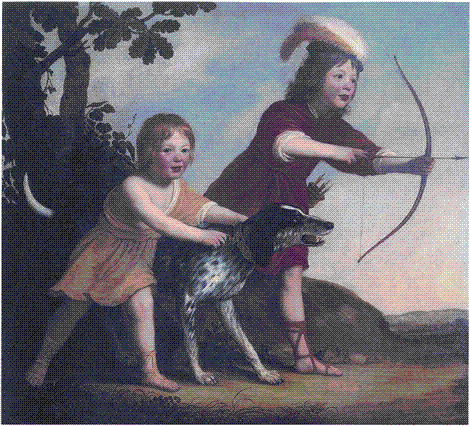
Gerard van Honthorst, Hieronymus and Frederik Adolf van Tuyll van Serooskerken. 1641. Canvas, 123 × 138 cm. M.A.O.C. Gravin van Bylandt Stichting, The Hague.
| |
| |
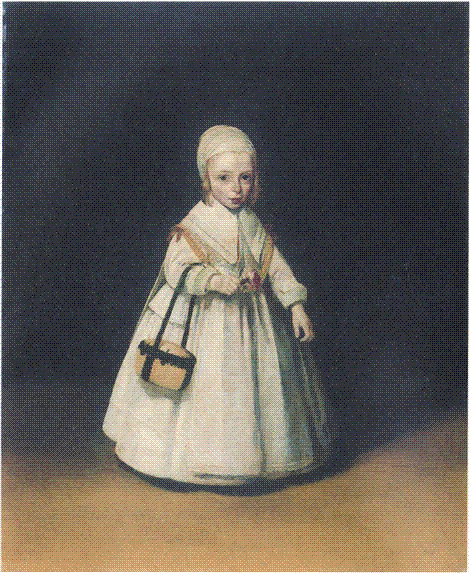
Gerard ter Borch, Helena van der Schalcke. c. 1648. Panel, 34 × 28.5 cm. Rijksmuseum, Amsterdam.
with a great deal of lace and looks at us as if about to ask whether this is the right pose. The painting is like a snapshot, and the same can be said of the Boy (possibly Jacob van Oost jr) by the Bruges painter Jacob van Oost sr.
It is perhaps not surprising that quite a lot of the children's portraits are painted by the father of the sitter. The combination of paternal love and artistic craftsmanship results in an intimacy which even today we can sense and recognise. The most fascinating and at the same time most puzzling portrait in the exhibition, however, was the anonymous Girl with a Dead Bird, which was exhibited in Antwerp only. It is a painting about which virtually nothing can be said with certainty, except that it is deeply moving.
lauran toorians
| |
| |
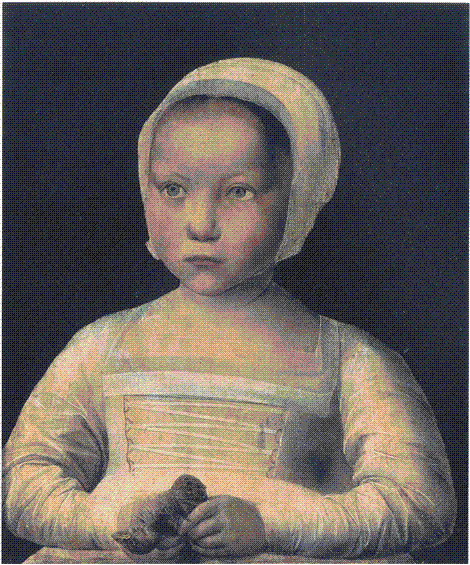
Anonymous, Girl with a Dead Bird. c. 1520. Panel, 36.5 × 29.5 cm. Koninklijke Musea voor Schone Kunsten, Brussels.
To bring the world of these children alive, the exhibition also showed some actual toys from the period. Toys from around 1600 are rare and only the most costly examples survived as heirlooms. Others have been discovered recently in archaeological excavations. In an essay in the catalogue Annemarieke Willemsen describes these toys (real and painted) and ‘the culture of play in the Netherlands around 1600’. Of special interest is also that for each of the paintings there are separate descriptions of the dress of the children. These have been done by Saskia Kuus, who has also written an introductory essay on ‘Children's Costume in the Sixteenth and Seventeenth Centuries’. Other essays deal with the position of children in the Protestant North and in the Catholic South and with the scope for education in the Netherlands during this Golden Age. The book (Jan Baptist Bedaux & Rudi Ekkart (eds.), Pride and Joy. Children's Portraits in the Netherlands 1500-1700. Ghent / Amsterdam, 2000) appeared both in a Dutch and in an English edition. |
|